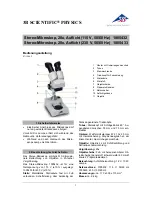
2 Safety | 2.3 Prevention of Hazards
ZEISS
2.3.7 Mechanical Hazards
Risk of injury:
Moving the
specimen stage
Fingers can be trapped by the moving specimen stage.
§
Always close the chamber door before moving the specimen stage.
§
To remove parts fallen into or near to the stage use a tool (e.g. tweezers) instead of your fin-
gers.
Risk of injury:
Closing the
chamber door
Fingers can be pinched when closing the chamber door.
§
Use the recessed grip or door handle to close the chamber door.
§
Ensure not to get your fingers caught in the chamber door gap.
Risk of property
damage: Short
working distance
When opening the chamber door, the microscope or specimen can be damaged if the specimen
stage is at a short working distance. If a BSD detector is inserted, it can be damaged as well.
§
Always move the specimen stage to a long working distance before opening the chamber
door.
2.3.8 Radiation Hazards
Danger to life: X-
rays
X-rays are generated inside the microscope during operation. This is unavoidable because elec-
trons are accelerated by voltages up to 30 kV.
§
Do not remove any parts around the column and chamber that are essential for radiation pro-
tection.
§
Use genuine ZEISS parts exclusively.
§
Ensure that all local safety and X-ray protection regulations are met.
§
Only authorized ZEISS service representatives are allowed to service the microscope.
The microscope is equipped with several radiation protection devices, which, under regular oper-
ating conditions, ensure that the microscope operates in accordance with the German X-ray pro-
tection regulation (RöV), the German radiation protection regulation (StrSchV) as well as with the
EC Directive 2013/59/EURATOM.
In the EU, the operation of the microscope is permission-free as the following requirements are
fulfilled:
§
The acceleration voltage is limited to 30 kV.
§
The local dose rate at a distance of 0.1 m from the accessible surface of the microscope does
not exceed 1 μSv/h.
§
A respective label is attached to the microscope.
Outside the EU, the user of the microscope has to comply with the local regulations of the coun-
try where the microscope is operated.
Radiation Protection
For questions regarding radiation protection, contact the ZEISS Radiation Safety Officer, Carl Zeiss
AG, 73447 Oberkochen, Germany
phone: +49 (0) 7364 20 0
2.3.9 Suffocation Hazards
Danger to life:
Lack of oxygen
Gaseous dry nitrogen is used to vent the specimen chamber during specimen exchange and parts
exchange. Inhaling nitrogen may cause unconsciousness.
§
During specimen exchange, keep the chamber door open as short as possible.
§
Do not inhale the air from within the specimen chamber.
§
Ensure that the area around the microscope is sufficiently ventilated.
§
If you begin to experience symptoms of asphyxia (for example: rapid breathing, loss of mental
alertness and/or muscular coordination, depression of sensations, emotional instability, fa-
tigue) leave the room immediately and inform the facility’s safety officer.
16
Instruction Manual ZEISS Crossbeam 350 | en-US | Rev. 3 | 349500-8111-000















































